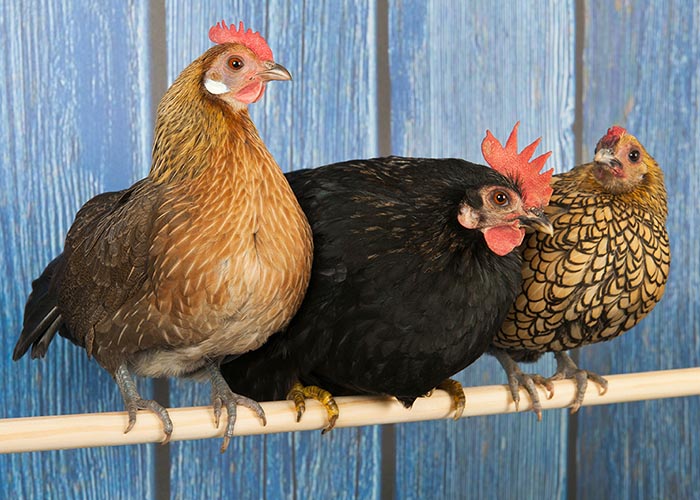
Small but mighty, many chicken enthusiasts enjoy raising bantam breeds. These petite poultry birds have all of the attributes of their full-size counterparts, but take up less space and eat less food… did we mention that they are endearing and delightful to watch? A bantam chicken is a small-sized chicken, some poultry lovers even refer to them as miniature chickens; many bantam breeds are smaller versions of larger, traditional chicken breeds. At The Cheshire Horse, we carry a number of bantam breeds and love introducing them to our customers. In this blog, we explore the various bantam chicken breeds that we carry so that you can order the right bantam chicks to join your flock. These chicks are not sexed, so expect to receive both pullets and cockerels in your order.
To learn more about the chicks available in the 2021 season, refer to our Chick Season 2021 page.
Ameraucana Bantam
The bantam that lays the colored egg! Their eggs are a bluish-green and they are treasured for this quality. They will lay around 180-200 eggs per year. Rather than ear tufts, these birds have muffs and a beard. They even have blue or slate-colored legs. Bantam Ameraucanas are known to be hardy and have a sweet docile personality. The Ameraucana is one of the United States’ newer breeds and, like their standard size relatives, come in many different colors and feather patterns.
Red Frizzle Cochin Bantams, Black Frizzle Cochin Bantams, and White Frizzle Cochin Bantams
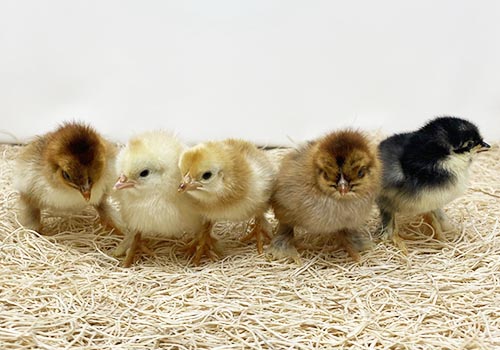
First mentioned in the 1600s, the Frizzle Cochin Bantam is truly a unique bird. Unlike all other chickens, the feathers on the Frizzle curve outward and forward, giving it the appearance of having walked backward through a wind storm. Frizzle Cochin Bantams come in red, white, and black cochin varieties. They are not prolific layers, but hens will lay around 120-150 cream or tinted eggs per year. They are occasionally broody and prove to be good mothers. Frizzle chicks can be a little slower than regular chicks in feathering out, so they may need additional time in the brooder. They are quiet and docile, and very tolerant to handling, which makes them a great family bird.
PLEASE NOTE: The frizzle feathering of these unique birds does not show as baby chicks. Because the frizzle trait does not breed true, approximately one-quarter of your frizzle chicks will develop normal feathering and the others will be frizzled.
Blue Laced Red Wyandotte Bantam
The Blue Laced Red Wyandotte Bantam Chicken is a beautiful and rare variety of Wyandotte Bantams. It comes from an older standard breed of American chicken that developed around 1870. The original variety of the heavy, soft feathered Wyandotte is the Silver Laced variety, but we also offer many different desirable and beautifully colored feather patterns. Wyandottes will brood frequently and they make excellent mothers.
This breed tends to be extremely docile and friendly with people and can be a great pet bird to keep for its utility, beauty, and personal enjoyment. They will make great mothers for other breeds of chickens or even other species of poultry. Bantam hens will mature around 24 oz, the roosters around 26 oz. You can expect them to lay around 200 light-brown eggs per year.
Cream Buttercup Old English Bantam
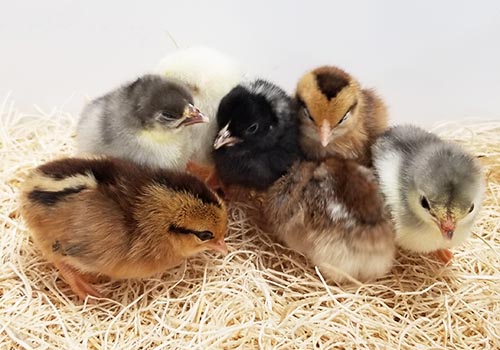
Old English Bantams were developed in England many years ago, presumably from the Common Crossbred bantams of the countryside. The Cream Buttercup Old English Bantam chicks are light yellow buff with black markings and black streaks down the back. They have single combs and clean, grey legs and feet.
Despite their small stature, Bantam Buttercups are found to be hardy and strong. Roosters weigh about 2 lb and hens weigh 1.8 lb and will lay approximately 100-120 eggs per year. Bantam Cream Buttercups are incredibly reliable and productive layers. They may lay smaller eggs, but they lay great quantities of them. This makes them a great egg production fowl for those who have less space or would prefer a lower feed bill. Generally, they get along well with other birds but are not overtly friendly toward people.
D’Uccle Mille Fleur Bantam
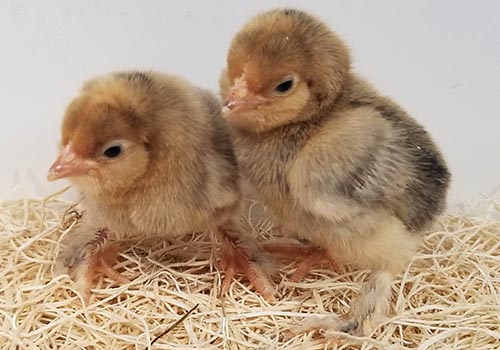
The D’Uccle Mille Fleur Bantam is a beauty to behold. Their plumage seems to sparkle in certain lights; they make very pretty ‘lawn ornaments’ and family pets. Each bird has a slightly different variation of plumage pattern so no two look alike. They are not renowned for fabulous egg-laying abilities, however, they do put out between 150-200 small, white, or tinted eggs. They are late to start laying eggs in spring but often keep going throughout the winter.
These are delightfully cheerful and talkative birds. They like to talk, sing, and trill. They will frequently fly up to your shoulders or lap and sit chatting away. Most of them enjoy being picked up and held and will sit contentedly in your hand, even taking a nap there! Roosters weigh in at 26 oz, with the hens weighing about 22 oz. They are a great bird for kids since they love to be petted and held. The calm, placid nature of the bird lends itself to shows and exhibitions, even the roosters. If you enjoy a bird that loves to be interactive with you, the D’Uccle may be it.
Mottled Japanese Bantam
Japanese Bantams originated in Southern China and arrived in Japan in 1603. They have attractive faces and heads with large red combs and wattles, stout little bodies, and very large tails. The Mottled Japanese Bantam is a unique coloration with black feathers flaked with many white spots, similar in coloration to the Mottled Cochin Bantam. Japanese Bantams are primarily raised for adding interest and elegance to the poultry yard. They lay only about one small, bantam-sized egg in a creamy white color each week. Without human attention and interaction, they can get flighty, but with attentive raising, they are quite friendly and a lot of fun. In areas with extremely cold winters, they will need extra protection.
Porcelain Bearded d’Uccle Bantam
The Porcelain is a popular variety of Belgian Bearded d’Uccle. The Porcelain pattern is similar to the Mille Fleur pattern, but with “diluting” genes, so that the Porcelains are pale where Mille Fleurs are dark. Their plumage consists of a base of parchment feathers, each one marked with a lavender blue crescent-moon, and tipped with a pale, gibbous spangle. Their mature coloring takes time to manifest and does not usually appear until after the first adult molt.
They are not renowned for fabulous egg-laying abilities, but they do put out between 150-200 small, white or tinted eggs a year. They are late to start laying eggs in spring but keep continuing through the winter. These are delightfully cheerful and talkative birds. They will frequently fly up to your shoulders or lap and sit chatting away for ages. Most of them enjoy being picked up and held and will sit contentedly in your hand, even taking a nap there! Roosters weigh in at 26oz, with the hens weighing 22oz. They are a great bird for kids to be around as they love to be petted and held. The calm, placid nature of the bird lends itself to shows and exhibitions, even the roosters! The sweet disposition of the adorable Porcelain D’Uccles makes them a must for anyone who likes pet bantams.
Silkie Bantams
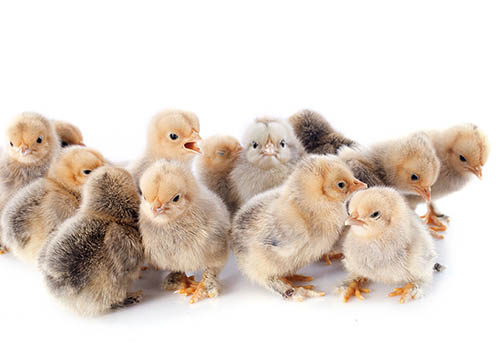
There is no doubt that the Silkie is a very old breed, most likely of Chinese origin. It is believed by many that the Silkie dates back as far as the Chinese Han Dynasty in 206 BC. The Silkie is a breed of chicken named for its unique, fluffy plumage, which is said to feel like silk. The breed has several other unusual qualities, such as dark blue flesh and bones, blue earlobes, and five toes on each foot (most chickens only have four). They come in various colors including, black, buff, blue, grey, red, white, partridge, lavender, splash, and cuckoo.
Silkies lay about 120 cream-colored eggs per year, but production is often interrupted due to their extreme tendency to go broody; a hen will produce 100 eggs in an ideal year. They are commonly used to hatch eggs from other breeds and bird species. In addition to being good mothers, Silkies are universally renowned for their calm, friendly temperament. They do well in confinement and interact very well with children. This docility can cause Silkies to be bullied by more active or aggressive birds when kept in mixed flocks. They are fluffy, tolerant, and love sitting in your lap… they even enjoy cuddles!
At The Cheshire Horse, we are proud to be your full-service poultry and farm supply store. If you have any questions regarding the various breeds of chicks that we carry, we encourage you to speak with a member of our friendly and knowledgeable sales staff. We would love to help you select the right chicks to join your homestead.

Wrong info silkies have black skin bogus advise!
Thanks for pointing that out! While it’s true that some Silkies have black skin, the majority have bluish-black, purplish-black, or even dark gray skin. The color can vary depending on the individual bird’s genetics and breed standard. It’s always important to consider the specific characteristics of each bird. If you have any more questions or need clarification, feel free to ask!